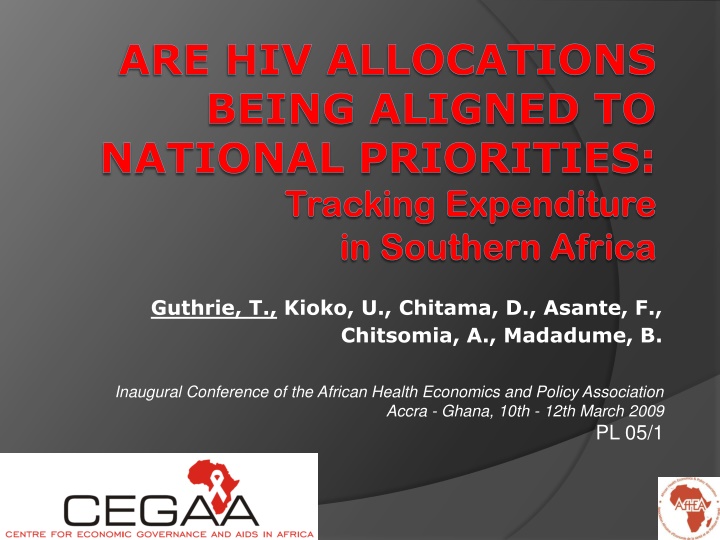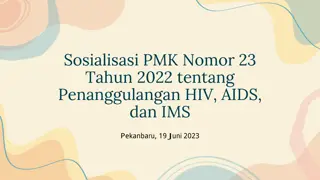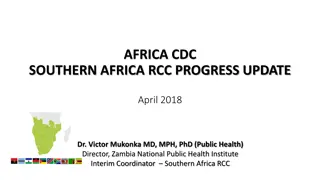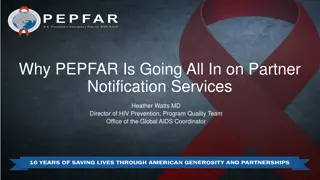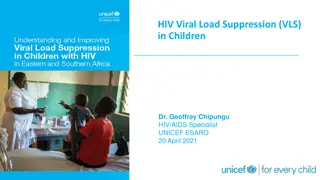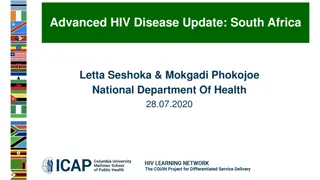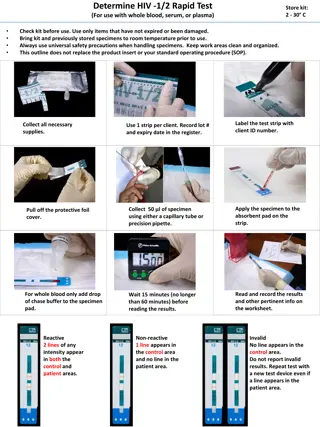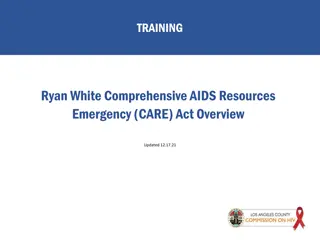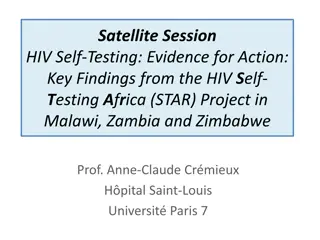Aligning HIV Allocations with National Priorities in Southern Africa
This study analyzes HIV/AIDS expenditure in Southern Africa to assess alignment with national priorities. It compares spending levels, funding sources, unit costs, and per capita spending across countries. The focus is on tracking funds for achieving National Strategic Plans and evaluating the adequacy and absorption of allocated resources. The methodology involves a comprehensive assessment of all HIV/AIDS spending to monitor progress towards national and international commitments.
Download Presentation

Please find below an Image/Link to download the presentation.
The content on the website is provided AS IS for your information and personal use only. It may not be sold, licensed, or shared on other websites without obtaining consent from the author.If you encounter any issues during the download, it is possible that the publisher has removed the file from their server.
You are allowed to download the files provided on this website for personal or commercial use, subject to the condition that they are used lawfully. All files are the property of their respective owners.
The content on the website is provided AS IS for your information and personal use only. It may not be sold, licensed, or shared on other websites without obtaining consent from the author.
E N D
Presentation Transcript
ARE HIV ALLOCATIONS BEING ALIGNED TO NATIONAL PRIORITIES: Tracking Expenditure Tracking Expenditure i in Southern Africa n Southern Africa Guthrie, T., Kioko, U., Chitama, D., Asante, F., Chitsomia, A., Madadume, B. Inaugural Conference of the African Health Economics and Policy Association Accra - Ghana, 10th - 12th March 2009 PL 05/1
Objectives To compare levels of spending, both domestic and international, for HIV/AIDS in 4 SADC countries: Botswana, Swaziland, Zambia, Lesotho -> Ghana (non-SADC comparison) To consider the adequacy and alignment of the funds for the attainment of their National Strategic Plans (NSPs). To measure the absorption of these funds according to the different funding mechanisms. To compare unit costs for key interventions (where output data was available )
Methodology Comparison of NASA Reports from the 4 countries National AIDS Spending Assessment is an approach to comprehensively measure: All spending for HIV/AIDS From all sources, through agents, providers, activities to beneficiaries From a multi-sectoral perspective According to interventions reflected in the NSPs Allows countries to monitor their own progress towards the national and international commitments. Acknowledgements to the NACs and NASA team members for their data
Levels and Sources of Financing Increasing amounts of spending on HIV/AIDS Increasing public allocations, as well as international Average contributions (in 4 countries): International 58.8%. Public 41.2%. Removing Botswana: International 71.6%. Public 28.4%.
Levels & Sources of Funding for HIV/AIDS (US$mill, 2006) 250 200 Millions 150 Internat. Contribution US$ 100 Public contribution 50 - Botswana Swaziland Zambia Ghana
Per Capita HIV/AIDS Spending & HIV Prevalence (US$, %, 2006) Per capita spending (US$, 2006) HIV prevalence rate (%, 2006) $136.98 $51.51 24.1 $17.62 $1.38 26.0 17.0 3.4 Botswana Swaziland Zambia Ghana
Increasing Public Allocations: Botswana ~ Total Spending on HIV/AIDS (PulaMill, 2003-2005) 1,200 1,000 800 PULA Millions International Funds Public funds 600 400 200 0 2003 2004 2005
Swaziland ~ Sources of HIV/AIDS Financing (SZLmill, 2005/06-2006/07) 400 350 SZL Millions 300 250 International Public 200 150 100 50 0 2005/06 2006/07
Zambia ~ Sources of HIV/AIDS Financing (US$, 2005&2006) 250,000,000 200,000,000 150,000,000 Int'l NGO Bilaterals Multilaterals Public 100,000,000 50,000,000 0 2005 2006
Ghana Sources of HIV/AIDS Financing (US$mill, 2005-2006) 35 30 25 US $ Millions 20 International Public 15 10 5 - 2005 2006
Lesotho (prelim) ~ Financing Sources for HIV/AIDS (M, 2005/06 & 2006/07) 300000000 250000000 200000000 International Public 150000000 100000000 50000000 0 2005/06 2006/07
Alignment with National Priorities Alignment with National Priorities
Swaziland ~ Comparison of Costed NSP with NASA Spending (SZL, 2006/07)
Zambia ~ NSP Costed Priorities vs Actual Spending (%, 2006) VI. Integrating Advocacy and Coordination of the Multi-sectoral Response V. Improving the monitoring of the multisectoral Response IV. Strengthening the Decentralized Response and mainstreaming HIV and AIDS Theme III. Mitigating the Socio-economic impact of HIV and AIDS II. Expanding Treatment, Care and Support I. Intensifying Prevention 0.0% 5.0% 10.0%15.0%20.0%25.0%30.0%35.0%40.0%45.0%50.0% Percentage Actual expenditure NASF Priorities
Botswana ~ NSP Priorities Compared to Actual Spending (%, 2005/06) Strengthen Legal & Ethical Enviro. 0 0.5 Psychosocial & Economic Impact 17 22.2 NSF Goals Mgmt of National Response 7 14.4 Care & Support (incl ARVs) 54 49.4 10 Prevention 13.6 0.0 10.0 20.0 30.0 % 40.0 50.0 60.0 NSF % Actual Spending %
Ghana ~ Costed APOW vs Actual Spending (US$, 2006) 30,000,000 25,000,000 20,000,000 US$ 15,000,000 Costed APOW Act.Expenditure 10,000,000 5,000,000 0 Treatment, Prevention & Mitigating the Advocacy & Surveillance & Managmt Mobilization of Coord. & Support Environ. Care & Research, Resources Policy, Impacts BCC M&E
Lesotho ~ Spending Compared to Costed NSP Priorities (%, 2006/07) 50 45 40 35 30 25 Costed NSP Act.Spending 20 15 10 5 0 Mgmt, Coord, Support Prevention Treatment & Care Impact Mitigation
Botswana ~ Spending on HIV/AIDS by Source (%, 2005) 100% FN 8. Research 90% FN 7. Community Develmt & Environment 80% FN 6. Social mitigation 70% 60% FN 5. Human Resources Incentives 50% FN 4. Prog.Devmt & HSS strengthening 40% FN 3. OVCs 30% 20% FN 2.Treatment and care 10% FN 1..Prevention Programmes 0% Public sector Internat.Orgs Total Pula
Swaziland ~ Effects of Reducing External Aid (SZL, 2005/06-2006/07) 400,000,000 350,000,000 HIV and AIDS realated research(Excluding operational research) Enabling Environment and Community Development Social Protection and Social Services (EXCLUDING OVC) Human Resources' recruitments and Retention Incentive - Human Capital ProgrammeManagement and administration strengthening OVC 300,000,000 250,000,000 SZL 200,000,000 150,000,000 Care and Treatments 100,000,000 Prevention 50,000,000 - 2005/ 2006 2006/ 2007 YEAR
Swaziland ~ Reducing Treatment (Nutrition Supplements) Spending (SZL, 2005/06-2007/08) Care and treatment services not elsewhere classified (n.e.c.) Opportunistic infections (OI) treatment 90,000,000 Home-based care 80,000,000 Palliative care 70,000,000 Psychological treatment and support services 60,000,000 50,000,000 Specific HIV-related laboratory monitoring SZL 40,000,000 Nutritional support associated to ARV therapy 30,000,000 Antiretroviral therapy not-desegregated by age or line of treatment 20,000,000 Adult antiretroviral therapy not- desegregated by line of treatment 10,000,000 Pediatric antiretroviral therapy not- desegregated by line of treatment - 2005/ 2006 2006/ 2007 Opportunistic infection (OI) prophylaxis YEAR
Absorptive Capacity Absorptive Capacity
Dimensions of Absorptive Capacity Program Management Procurement and Supply Chain Financial management Governance & oversight Performance and measurement This focus is on the financial aspects
Financial Absorptive Capacity Ability of implementing agencies to utilise funds in the planned time period and for the purposes intended Rate and manner by which funds received are turned into physical resources of materials, equipment, infrastructure, and personnel Encompasses financial flow: from commitment through transfer or disbursement to procurement or expenditure
Zambia absorption rates improving (US$, 2005 & 2006) 250 Av.88% 200 Av.72% 150 Pula Millions Allocations Actual Spending 100 50 - 2005 2006
Factors Limiting Absorptive Capacity Limited human resources & skills at all stages of project conceptualisation, implementation & monitoring High rate of turn-over and deaths of staff Preferential use of funding (according to source) Governmental ceilings for development / social sector spending frozen posts Delayed disbursements (some funding mechanisms worse than others) Complexity of reporting and accounting requirements and other conditionalities absorb staff time Govt procurement systems very slow Short project cycles and disbursement cycles
Summary of Findings Evidence of improving public contribution to total spending on HIV/AIDS Some decreases in external sources (Swaziland & Lesotho) Treatment (specifically ART) requiring increasing amounts Prevention not receiving notably increased allocations Other interventions (mitigation, enabling environment, research) receiving relatively little
Findings cont. Comparing the costed NSP priorities with the actual spending: NSPs generally poorly costed and may not have been accepted in country NASA captured more than was included in the NSP costing Improving costings and use of NASA will better provide estimates of funding gaps by intervention There are improvements ito donor alignment with national priorities (according to the Paris Declaration) Eg. Increasing allocations through common funds for HIV/AIDS, managed by the NACs However, there are some notable exceptions Parallel systems of financial management remain
Findings cont. Comparison of unit costs of key interventions within the SADC region has been difficult due to poor or non-comparable out-put indicators. The funding mechanism appears to influence the degree of absorption of funds, among many other factors Often poor absorption due to delays in disbursement systems, and dumping by donors Measuring the absorption of funds proved difficult because the NASA approach initially did not collect the allocations/ commitments / disbursements only the actual spending so the rate could not be calculated. Only in Zambia....
NASA Provides Data for Evidence NASA Provides Data for Evidence- -based Allocative Allocative Decisions Decisions based Adequacy of funding public & external Allocative decisions priorities Efficiency of spending & absorption rates/ challenges Coordination, Harmonisation and Alignment Enhanced Transparency, Accountability & Economic Governance Standardization & Comparability Need for institutionalization of resource tracking in routine M&E systems:
Routine Resource Tracking would. Increase pressure (& desire) for mutual accountability by all players Promote a framework to ensure all partners report through a national resource tracking system Link framework to the National Resource Mobilisation and Management Strategy Contribute to harmonised standards of reporting and costing among different partners Ensure transparent procurement systems & best pricing within and between countries & regions
Thank You Teresa Guthrie Centre for Economic Governance and AIDS in Africa Email: teresa@cegaa.org Tel: +27-21-425-2852 Cell: +27-82-872-4694
